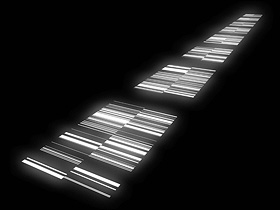

Ryoji Ikeda’s new project test pattern is interrelated with his datamatics project. test pattern is a system to convert any kind of data (text, sounds, photos and movies) into barcode patterns and binary patterns of 0s and 1s. Through its application, the project’s aim is to examine the relationship between critical points of device performance and the threshold of human perception.
In the first edition of the project, an audiovisual installation, test pattern is a sequence of tests for machines and humans, comprising visual patterns converted and generated from sound waveforms in real-time.
The installation comprises 8 computer monitors and 16 loudspeakers aligned on the floor in a dark space. The 8 rectangular surfaces of the screens flicker intensely with black and white images, floating and convulsing in the darkness. 16-channel sound signals are mapped as a grid matrix, passing and slicing the space sharply. Via a real-time computer program, the signal patterns are converted into 8 barcode patterns, which are tightly synchronized. The velocity of the moving images is ultrafast, some hundreds of frames per second at certain points, providing a performance test for the devices and a response test for visitors’ perceptions.
*as part of the project, driven by the same concept, test pattern CD is released on German label raster-noton (www.raster-noton.de), 25 February 2008
concept, composition: Ryoji Ikeda
computer programming: Tomonaga Tokuyama
commissioned by Yamaguchi Center for Arts and Media (YCAM), 2008